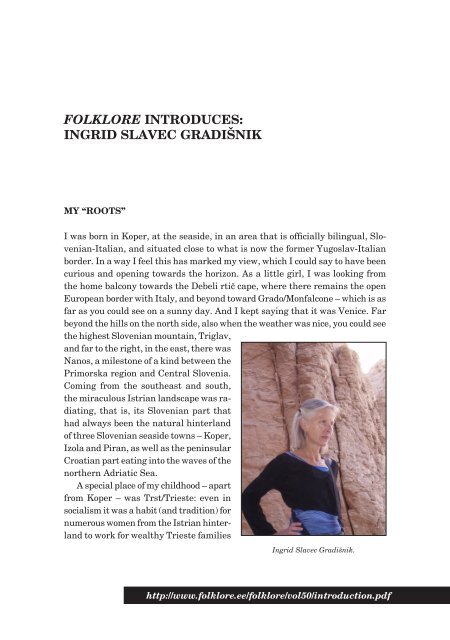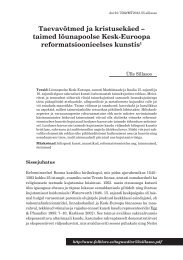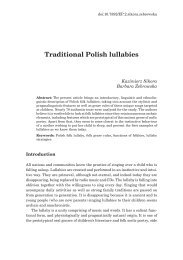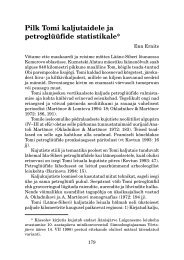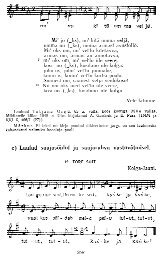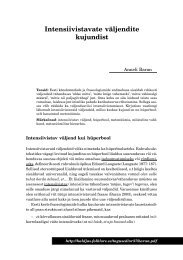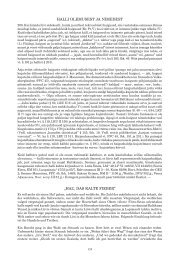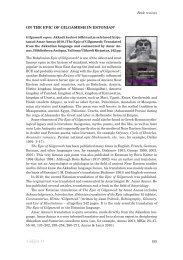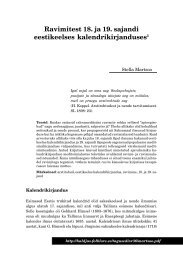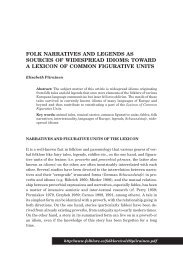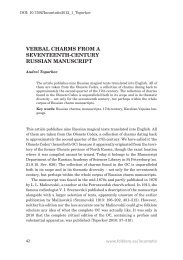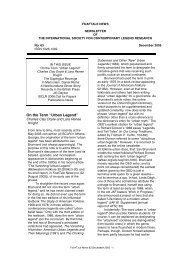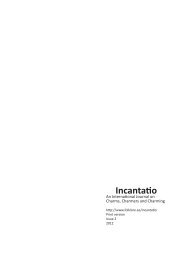folklore introduces: ingrid slavec gradišnik - Folklore.ee
folklore introduces: ingrid slavec gradišnik - Folklore.ee
folklore introduces: ingrid slavec gradišnik - Folklore.ee
You also want an ePaper? Increase the reach of your titles
YUMPU automatically turns print PDFs into web optimized ePapers that Google loves.
FOLKLORE INTRODUCES:<br />
INGRID SLAVEC GRADIŠNIK<br />
MY “ROOTS”<br />
I was born in Koper, at the seaside, in an area that is officially bilingual, Slovenian-Italian,<br />
and situated close to what is now the former Yugoslav-Italian<br />
border. In a way I f<strong>ee</strong>l this has marked my view, which I could say to have b<strong>ee</strong>n<br />
curious and opening towards the horizon. As a little girl, I was looking from<br />
the home balcony towards the Debeli rtič cape, where there remains the open<br />
European border with Italy, and beyond toward Grado/Monfalcone – which is as<br />
far as you could s<strong>ee</strong> on a sunny day. And I kept saying that it was Venice. Far<br />
beyond the hills on the north side, also when the weather was nice, you could s<strong>ee</strong><br />
the highest Slovenian mountain, Triglav,<br />
and far to the right, in the east, there was<br />
Nanos, a milestone of a kind betw<strong>ee</strong>n the<br />
Primorska region and Central Slovenia.<br />
Coming from the southeast and south,<br />
the miraculous Istrian landscape was radiating,<br />
that is, its Slovenian part that<br />
had always b<strong>ee</strong>n the natural hinterland<br />
of thr<strong>ee</strong> Slovenian seaside towns – Koper,<br />
Izola and Piran, as well as the peninsular<br />
Croatian part eating into the waves of the<br />
northern Adriatic Sea.<br />
A special place of my childhood – apart<br />
from Koper – was Trst/Trieste: even in<br />
socialism it was a habit (and tradition) for<br />
numerous women from the Istrian hinterland<br />
to work for wealthy Trieste families<br />
Ingrid Slavec Gradišnik.<br />
http://www.<strong>folklore</strong>.<strong>ee</strong>/<strong>folklore</strong>/vol50/introduction.pdf 135
<strong>Folklore</strong> Introduces<br />
and earn an additional income, both to provide for their own families and to be<br />
able to afford all the goods that were not available in the socialist Yugoslavia.<br />
Border residents had special passports, the so-called passes (It. lasciapassare),<br />
which enabled us to visit Italy four times a month, and later in the 1970s even<br />
more often. We would buy washing powder, footwear, textiles in Muggia, a<br />
small town ahead of Trieste, and in Trieste itself. Before Euros, in Italy you<br />
would pay in lire, which women also earned by taking a kilo of meat, a packet<br />
of butter, and eggs to Trieste and exchanging these for household items with<br />
drugstore owners. It would be difficult ever to forget the journeys to Trieste<br />
by a boat that departed from Koper two or thr<strong>ee</strong> times daily, and the excellent<br />
ice-cream in Trieste, which my mother would buy for me.<br />
During secondary school, I started to s<strong>ee</strong> Trieste differently: it was where I<br />
would go to buy music (the famed LPs), books, s<strong>ee</strong> art exhibitions, visit cinemas<br />
and theatres. This, apart from Italian television, was a window on the so-called<br />
“Western” world, as well as a reflection of the glitter of Austro-Hungarian monarchy’s<br />
westernmost part, and to me it still remains an exciting combination<br />
of Central and Mediterranean Europe. And also a city where Slovenians have<br />
found it hard to reside form the Fascist times onwards!<br />
When in the mid-1970s I came to Ljubljana to study, I noticed that the horizon<br />
of people living near the Italian border was a bit “different”. It was as if<br />
we had b<strong>ee</strong>n carrying in us a different spirit that was difficult to grasp. I found<br />
the decision about what to study easy and difficult at the same time. With my<br />
interests going in the cultural and humanistic direction, as well as languages<br />
(I had b<strong>ee</strong>n learning Italian and English since primary school, also French in<br />
secondary school), I knew exactly what not to study. At the Faculty of Arts,<br />
I could study anything. I enrolled for the double-subject study of Slovenian<br />
language and literature (the major or A subject) and history of art (the minor<br />
or B subject).<br />
EDUCATION<br />
My secondary school teachers were mostly excellent and I was particularly<br />
inspired by a young teacher of Slovenian language and literature, who once<br />
invited her colleague with a degr<strong>ee</strong> in ethnology to our school literary group.<br />
This was probably the first time I had heard about ethnology. The talk with<br />
him remained somewhere at the back of my mind until the long holidays after<br />
the matura exam and before entering the university. Then, travelling around<br />
Europe, close to Copenhagen, I found myself in the company of two boys and<br />
a girl who studied ethnology. I realised how ethnology was opening up a view<br />
136 www.<strong>folklore</strong>.<strong>ee</strong>/<strong>folklore</strong>
<strong>Folklore</strong> Introduces<br />
towards everything I was really interested in: the diversity of cultures, histories,<br />
places, people and their fates. And so, when enrolling officially at the university,<br />
I swiftly replaced art history with ethnology, and after the first year registered<br />
it as the second major (A).<br />
UNIVERSITY<br />
Many are disappointed with their studies. I wasn’t. I kept in mind what the<br />
secondary school class teacher told us as a farewell, saying that surely we<br />
believed it was the end of annoying classes, but even in what we had chosen<br />
to study, we would still find at least half of the classes and obligations to be<br />
redundant and off-putting. I have always loved literature, whereas studying<br />
the secrets of my mother tongue has given me many valuable things – first,<br />
it made me aware of my own literacy, but mostly it made me realize how the<br />
world and relations betw<strong>ee</strong>n people in their most part are actually interlaced<br />
in the language. Today, for example, this knowledge helps me also with my<br />
editorial work. On the other hand, at the Department of Ethnology, there was<br />
Professor Vilko Novak, an eminent expert on philology and ethnology, who kept<br />
persuading me about the importance of philological education. When I began my<br />
studies, he was the only full professor at the department, and lectured on the<br />
ethnology of Slovenians, ethnology of Southern Slavs and European ethnology.<br />
Naturally, I only began to appreciate him after I finished my studies, and later<br />
on in my car<strong>ee</strong>r path. Except for two or thr<strong>ee</strong> assistants, the second lecturer at<br />
the department was the associate professor Slavko Kremenšek, who had b<strong>ee</strong>n<br />
introducing “revolutionary” views into Slovenian ethnology since the 1960s. He<br />
turned the future development of our discipline away from its traditional ethnographic<br />
frameworks, which he achieved particularly by focusing ethnological<br />
research elsewhere than solely on the past, on rural areas and the remnants<br />
of the “old” culture. To student generations of the 1970s and 1980s, he opened<br />
up a perspective on everyday culture, contemporary cultural manifestations<br />
and cities, and related past and contemporary cultural phenomena to various<br />
generational, social, professional and local groups. It could be said that he<br />
provided research into everyday life with social-anthropological foundations,<br />
which s<strong>ee</strong> culture not as a single and unique entity but as a strongly historically<br />
and socially informed phenomenon. He thus balanced the relationship<br />
betw<strong>ee</strong>n the discipline’s practice and theory. He became my mentor in the<br />
noblest sense of the word.<br />
<strong>Folklore</strong> 50 137
<strong>Folklore</strong> Introduces<br />
MY INTERESTS<br />
I was particularly drawn by theoretical aspects, which was due to several reasons:<br />
intimately, I had always b<strong>ee</strong>n interested in the adventures of the human<br />
spirit, and – which is already related to ethnology – in theory I saw the key<br />
non-explicated or explicated stock of knowledge, which, apart from the skill<br />
of narration, is what to a great extent creates inspiring or lame, “better” or<br />
“worse” ethnological/anthropological texts, which are more or less convincing<br />
in the sense of thematising both universal and specific phenomena of human<br />
existence. The first founding-fathers that I read with such a sensibility, of<br />
course, were Malinowski and Lévi-Strauss.<br />
MY BA DEGREE<br />
My diploma thesis on the Slovenians in Mannheim, Germany, served two purposes:<br />
it was prepared in the seminar dedicated to the research of Slovenian<br />
emigrants and it integrated my Slovenian and ethnological studies; it was also<br />
admitted as a diploma thesis at both departments. My main topic of interest<br />
was linguistic communication both in German and in Slovenian, as was then<br />
practiced in Slovenian families living abroad due to temporary working migration.<br />
In principle it explored bilingual asymmetry, which is typical of migrant<br />
communities, but not as a unified concept because communicative practices<br />
in the mother tongue and in a foreign language depend largely on the social<br />
position, education, social networks, contacts with the country of origin, future<br />
plans (to remain abroad or return home), etc., and eventually on the attitude<br />
towards the mother tongue and homeland in general.<br />
EMPLOYMENT<br />
During my studies, I wasn’t worrying about what to do for a living. Actually,<br />
there weren’t many jobs in ethnology: at the time ethnologists would mostly<br />
work in museums, in institutes for heritage protection, whereas the majority<br />
of them would find jobs based on their education in other specialties. Towards<br />
the end of my studies I somehow knew I didn’t want to be a secondary school<br />
Slovenian teacher. I really wanted and hoped to do something related to ethnology.<br />
Already while studying, I helped in the department library on a regular<br />
basis, thus learning about library and secretarial duties. Since I was a good<br />
student, Prof Kremenšek would have offered me a position as an assistant if it<br />
138 www.<strong>folklore</strong>.<strong>ee</strong>/<strong>folklore</strong>
<strong>Folklore</strong> Introduces<br />
had b<strong>ee</strong>n possible, but it wasn’t. As the then librarian was just switching jobs,<br />
I thus came to the library after graduating, to the world I love so much – being<br />
surrounded by books. I stayed there for four years until a position for an<br />
assistant in general ethnology was opened.<br />
PhD RESEARCH<br />
In the meantime I began my postgraduate studies, the topic of my postgraduate<br />
thesis having b<strong>ee</strong>n the development, or rather, a thorough overview of the<br />
tendencies in post-World War II ethnology in Slovenia. The topic then grew<br />
so much that the professor advised me to elaborate it as a doctoral thesis. As<br />
in the following years I undertook a series of lectures and seminars, which<br />
together with other work with students occupied all of my time, and became a<br />
mother, I was quite late in obtaining my PhD, only when turning 42. By then I<br />
had thoroughly studied the history of ethnology in Slovenia and abroad, which<br />
convinced me of the cumulative nature of knowledge production in humanities,<br />
and of the n<strong>ee</strong>d to balance historicist and presentist approaches in dealing with<br />
the history of the discipline. The most valuable of the findings, as I thought and<br />
as was later affirmed by research into the formation and work of individual<br />
researchers, was that the so-called objective aspects or determinants that institute,<br />
co-produce and govern the discipline’s trends, coexist with a number of<br />
ostensible contingencies of a more subjective nature (individuals’ affinities and<br />
characters, their views of the world, individual trajectories, interpersonal and<br />
institutional networks, reception of discipline’s tradition), in short, everything<br />
that belongs to self-reflexive research into scholarly practices and the production<br />
of knowledge. Also, a part of this, to a certain extent, is the dis/loyalty to<br />
the “fashion” in scholarship, which has b<strong>ee</strong>n a typically global phenomenon,<br />
not only today, but even a century or two ago. Science is global or international,<br />
therefore local disciplinary traditions get caught in it in a varying dynamics,<br />
sometimes sooner, sometimes later, and more or less intensely. After all, this<br />
is the starting point and condition for our international communication. And<br />
if I had to single out one of the several authors that have made an important<br />
contribution to expand the field of issues related to the discipline’s history, it<br />
would surely have to be George W. Stocking, Jr.<br />
Even in the most difficult times – which for our forerunners were the decades<br />
following World War II, for which it often s<strong>ee</strong>ms that the socialist regime was<br />
firmly closing the door to the experts hoping for a comparative dialogue, they<br />
were actually able to find a way and ensure it. In this respect, the Yugoslavian<br />
regime as compared to other countries of the so-called Eastern, socialist block,<br />
<strong>Folklore</strong> 50 139
<strong>Folklore</strong> Introduces<br />
was “softer”. My generation experienced hard times, but of course to a much<br />
lesser extent, in the 1980s when the “Yugoslav crisis” was severely limiting<br />
our financial options. The majority was thus mostly k<strong>ee</strong>ping in touch with the<br />
international science through reading rather than mobility. It is difficult to<br />
imagine it today how valuable each foreign book or journal was to our libraries<br />
that had to buy it.<br />
WORKING AT UNIVERSITY<br />
I was employed by the Faculty of Arts for almost two decades. This was an<br />
exceptional time for my maturing, both professionally and personally, and<br />
marked by my studies as well as generations of students. When taken seriously<br />
by the lecturer, teaching is demanding and strenuous. In recent decades, this<br />
responsibility might have grown due to the exceptional production of findings<br />
in the discipline and outside it, making it quite difficult to follow. In such circumstances<br />
we can only dream of the meticulousness of our older professors.<br />
Today, we are faced with a much different style of production within the discipline,<br />
often much shallower and more cursory as compared to the impressions<br />
acquired when reading older texts. However, a teacher first and foremost has<br />
to open the doors and windows to knowledge, curiosity, and responsibility, but<br />
also sensitivity both to the distinctions in the issues being raised today and to<br />
the style of research.<br />
WORKING AT A RESEARCH INSTITUTE<br />
Somehow, I also experienced this when changing jobs. That is to say, about a<br />
decade ago I moved from the university to a research institute with different<br />
work routines. Here I am allowed more time, which I missed while lecturing,<br />
so enabling me “slower” and more in-depth study and writing.<br />
OUR INSTITUTE<br />
The Institute of Slovenian Ethnology at the Research Centre of the Slovenian<br />
Academy of Sciences and Arts, where I work now, alongside the Institute of<br />
Ethnomusicology, is the central solely research-oriented institute for ethnology<br />
and <strong>folklore</strong> studies. Similar to university, where teaching is connected<br />
to research, the latter here is connected to teaching, although the scale is<br />
140 www.<strong>folklore</strong>.<strong>ee</strong>/<strong>folklore</strong>
<strong>Folklore</strong> Introduces<br />
smaller. Namely, many researchers teach as external or guest lecturers at four<br />
Slovenian universities (Ljubljana, Maribor, Koper, Nova Gorica – the latter<br />
hosting a special RC SASA postgraduate programme). I also kept lecturing in<br />
Ljubljana for a year, then several years in Koper, at the Faculty of Humanities,<br />
where there is a department for cultural studies and anthropology. Research<br />
and teaching is a good and tempting combination, enabling the researcher to<br />
transfer their findings and test them in a way, particularly as regards their<br />
relevance and applied aspects. Above all, working with students forces you to<br />
k<strong>ee</strong>p in touch with the latest results in domestic and foreign scholarship. And<br />
simply enables you not to grow old.<br />
As I have said already, the nature of work in a research institute is much<br />
different. In Slovenia, research institutes are financed through local and international<br />
research project tenders, therefore our survival depends on the<br />
success of our applications. Sometimes, this means cruel battles and competition,<br />
as in principle there is no stable finance for continuous research. I am<br />
particularly referring to fundamental research, which provides for a continuity<br />
of research relevant to the national culture, the knowledge of which is crucial<br />
for any intercultural comparison. The institute is currently implementing the<br />
research programme “Cultural Spaces and Practices: Ethnology and <strong>Folklore</strong><br />
Studies” (2009–2014), with everybody employed at the institute participating<br />
in it (currently there are 17 people, of whom eight are PhD researchers, four<br />
young researchers, a documentation assistant, a secretary, a librarian, a research<br />
assistant and a technical assistant), and several projects with researchers<br />
participating based on their specific competences. This is the reason that our<br />
work unfortunately is often more fragmentary than we would have wished for,<br />
as intense input is required within several research projects. On top of the fact<br />
that the institute takes care of its archives and documentation, it k<strong>ee</strong>ps its own<br />
library and a special audiovisual laboratory that develops visual researches<br />
into culture and provides a large video archive. Senior researchers also serve<br />
as mentors to young ones who are training for their own academic car<strong>ee</strong>r, completing<br />
their doctoral theses. We edit two scientific journals (Traditiones and<br />
Studia mythologica Slavica) and thr<strong>ee</strong> book series (Opera ethnologica Slovenica,<br />
Ethnologica – Dissertationes and Slovenski pravljičarji [Slovenian Storytellers]).<br />
Our editorial work is demanding in the sense of the amount of time it takes.<br />
I am particularly glad for both our journals to have an international profile,<br />
which has b<strong>ee</strong>n achieved by being open thematically and having a rigorous<br />
editing process. Authors of articles are Slovenian and foreign researchers. We<br />
also publish topical volumes, often in English, to reach as many readers as<br />
possible in the international scholarly community. Also helpful in this view is<br />
our international editorial board with eminent foreign experts, two Slovenian<br />
<strong>Folklore</strong> 50 141
<strong>Folklore</strong> Introduces<br />
academicians and experienced former editors. Except for the most recent year,<br />
the articles are also available on-line on the journal’s homepage.<br />
PROFESSIONAL & PRIVATE LIFE<br />
Ethnologists mostly believe ethnology to be life itself. And being unable to<br />
delineate my professional and personal life clearly, this is how I s<strong>ee</strong> it myself.<br />
At the institute I have my working space, which I use thoroughly in the morning,<br />
sometimes also in the afternoon and even on Saturdays and Sundays, if<br />
necessary. But this is far from saying that my work and my thoughts stop and<br />
switch over when I step out of the door of the institute. We cannot be like always<br />
in the field. Currently I have b<strong>ee</strong>n involved in two new research projects<br />
exploring the transformation of festive practices and the issue of evaluating<br />
the relationship betw<strong>ee</strong>n nature and culture, i.e., natural and cultural heritage,<br />
with Triglav national park serving as an example, while I also continue<br />
researching the history and methodology of ethnology in Slovenia in a comparative<br />
European context.<br />
On top of this fundamental work, the researcher often gets burdened with a<br />
plethora of minute, often bureaucratic tasks, which are also of key importance<br />
for the institute to function smoothly, while some others might support local<br />
ethnology at least indirectly. Considering all this, there is only little time left<br />
for leisure – for the family, walks, reading. I am thus looking forward to summer<br />
ever again, when I have the time to relax for a w<strong>ee</strong>k or two in Slovenian<br />
mountains or somewhere in the Mediterranean, preferably in a quiet place<br />
somewhere on Croatian or Gr<strong>ee</strong>k islands. But even then my spectacles have<br />
ethnological lenses.<br />
REFERENCES<br />
BA, 1981: Slovenci v Mannheimu. Poskus etnološko-jezikoslovne predstavitve. [Slovenians<br />
in Mannheim: An attempt at ethno-linguistic presentation.] Department of Ethnology,<br />
Faculty of Arts, University of Ljubljana.<br />
Publ.: Slavec, Ingrid: Slovenci v Mannheimu. [Slovenians in Mannheim.] Ljubl-<br />
jana, 1982.<br />
PhD, 1998: Med narodopisjem in antropologijo. Teoretsko-metodološka vprašanja in<br />
odgovori v etnologiji na Slovenskem. [Betw<strong>ee</strong>n narodopisje and anthropology: Theoretical-<br />
methodological issues in Slovenian ethnology.] Department of Ethnology and Cultural<br />
Anthropology, Faculty of Arts, University of Ljubljana.<br />
142 www.<strong>folklore</strong>.<strong>ee</strong>/<strong>folklore</strong>
<strong>Folklore</strong> Introduces<br />
Publ.: Slavec Gradišnik, Ingrid: Etnologija na Slovenskem. Med čermi narodo-<br />
pisja in antropologije. [Ethnology in Slovenia: betw<strong>ee</strong>n the r<strong>ee</strong>fs of narodopisje<br />
and anthropology.] Ljubljana, 2000.<br />
EDITED AND CO-AUTHORED BOOKS<br />
Slavec, Ingrid (et al., eds.). Etnološka stičišča/ Zbieżności etnologiczne/ Ethnological<br />
contacts – 1. Ljubljana, 1988.<br />
Slavec, Ingrid & Dolžan Eržen, Tatjana (eds.). Zgodovinske vzporednice slovenske in<br />
hrvaške etnologije – 5. [Historical parallels of Slovenian and Croatian Ethnology.]<br />
Ljubljana, 1988.<br />
Kremenšek, Slavko; Slavec, Ingrid & Dolžan Eržen, Tatjana (eds.). Etnologija in domoznanstvo.<br />
[Ethnology and Heimatkunde.] Ljubljana, 1989.<br />
Hribar, Daša; Jezernik, Božidar; Ostromecka-Fraczak, Božena & Slavec Gradišnik,<br />
Ingrid (eds.). Etnološka stičišča / Zbieżności etnologiczne / Ethnological contacts<br />
– 3. Ljubljana, 1991.<br />
Bogataj, Janez & Slavec Gradišnik, Ingrid (et al., eds.). Kolesar s Filozofske. Zbornik v<br />
počastitev 90-letnice prof. dr. Vilka Novaka. [The cyclist from the Faculty of Arts:<br />
Papers honoring the 90th anniversary of Professor Vilko Novak.] Ljubljana, 2000.<br />
Hudelja, Mihaela; Hazler, Vito & Slavec Gradišnik, Ingrid. Podobe pokrajin 1956–1970.<br />
Etnološka fototeka Vilka Novaka. [Images of regions 1956–1970: Vilko Novak’s<br />
ethnological photographs archive.] Ljubljana, 2001.<br />
Slavec Gradišnik, Ingrid & Ložar-Podlogar, Helena (eds.). Pretrgane korenine. Sledi<br />
življenja in dela Rajka Ložarja. [Displaced roots: the life and work of Rajko<br />
Ložar.] Ljubljana, 2005.<br />
Slavec Gradišnik, Ingrid & Ložar-Podlogar, Helena (eds.). Čar izročila. Zapuščina Nika<br />
Kureta (1906-1995). [The magic of tradition: the legacy of Niko Kuret (1906–<br />
1995).] Ljubljana, 2008.<br />
Slavec Gradišnik, Ingrid (ed.). Etnološki pogledi in podobe. [Ethnological perspectives<br />
and images.] Ljubljana, 2009.<br />
Slavec Gradišnik, Ingrid & Radojičić, Dragana (eds.). Srbi v Sloveniji, Slovenci v Srbiji.<br />
[Serbs in Slovenia, Slovenians in Serbia.] Ljubljana, 2010.<br />
Slavec Gradišnik, Ingrid (ed.) & Ivančič Kutin, Barbara. Živa pripoved v zapisu. Kontekst,<br />
tekstura in prekodiranje pripovedi Tine Kravanja iz Bavšice. [A written record<br />
of live storytelling: context, texture, and transcoding of stories told live by Tina<br />
Kravanja from Bavšica.] Ethnologica – Dissertationes 3, Ljubljana, 2011.<br />
SELECTED ARTICLES<br />
„Historična etnologija“ ali o etnologiji kot vedi o preteklosti. [«L'ethnologie historique»<br />
ou l'ethnologie comme étude du passé.] Traditiones 1987, Vol. 16, pp. 51–72.<br />
<strong>Folklore</strong> 50 143
<strong>Folklore</strong> Introduces<br />
Etnološko preučevanje etnične identitete slovenskih izseljencev. [Ethnological research<br />
of ethnic identity of Slovenian emigrants.] Dve domovini [Two Homelands] 1990,<br />
Vol. 1, pp. 309–317.<br />
Slowenian ethnology betw<strong>ee</strong>n the past and the present. Ethnologia slavica 1990, Vol.<br />
22, pp. 217–242.<br />
„The own“ and „the foreign“ or on the interpretation of cultural-ethnical-national differences.<br />
Etnološki pregled 1990, Vol. 26, pp. 87–98.<br />
O etnologiji in leksikografiji. Slovenski etnološki leksikon med zamislijo in izidom. [On<br />
ethnology and lexicography: the lexicon on Slovenian ethnology betw<strong>ee</strong>n conception<br />
and publication.] Traditiones 2005, Vol. 34, No. 2, pp. 87–107.<br />
“Narodu v slavo in učenosti v napredek”. Recepcija Gregorja Kreka v slovenski etnologiji.<br />
[“To the glory of the nation and to the advancement of learning”: the reception<br />
of Gregor Krek in Slovenian ethnology.] Anzeiger für slavische Philologie 2006,<br />
Vol. 33 (2005), pp. 93–113.<br />
Etnološka branja Gregorja Kreka. [Ethnological readings of Gregor Krek.] Traditiones<br />
2006, Vol. 35, No. 2, pp. 205–233.<br />
Scraps of the history of ethnology in Slovenia. Česky lid 2008, Vol. 95, No. 1, pp. 37-62.<br />
Pogledi in podobe. K vprašanjem o produkciji znanja I. [Perspectives and images: fragments<br />
of knowledge production in etnology I.] Traditiones 2008, Vol. 37, No. 2,<br />
pp. 217–250.<br />
Slovenian folk culture. Betw<strong>ee</strong>n academic knowledge and public display. Journal of<br />
<strong>folklore</strong> research 2010, Vol. 47, No. 1/2, pp. 123–151.<br />
“Marxistický program” v slovinskej etnológii?. [The “Marxist” agenda in Slovenian ethnology?]<br />
Slovensky národopis 2010, Vol. 58, No. 4, pp. 478–495.<br />
Etnologija v Sloveniji in Srbiji. Dve tradiciji “jugoslovanske” etnologije? [Ethnology in<br />
Slovenia and Serbia: two traditions of “Yugoslav” ethnology?] Traditiones 2010,<br />
Vol. 39, No. 1, pp. 15–30.<br />
On <strong>folklore</strong> and <strong>folklore</strong> studies in Slovenia. Balgarski folklor 2011, Vol. 37, special<br />
edition, pp. 5–22.<br />
Zadnje desetletje od šestih. Inštitut za slovensko narodopisje ZRC SAZU (1951/2001–<br />
2011). [The last of the six decades: the Institute of Slovenian ethnology ZRC SAZU<br />
(1951/2001-2011).] Traditiones 2011, Vol. 40, No. 1, pp. 115–138.<br />
The Institute of Slovenian Ethnology ZRC SAZU (1951-2001). Ethnologia europaea<br />
centralis 2011, Vol. 10, pp. 81–86.<br />
CHAPTERS IN BOOKS<br />
Težnje v povojni slovenski etnologiji. [Trends in post-war Slovenian ethnology.] In: Bo-<br />
gataj, Janez and Marko Terseglav (eds.). Zbornik 1. kongresa jugoslovanskih etnologov<br />
in folkloristov: Rogaška Slatina, 5.–9.10.1983: 30. kongres Zveze društev folkloristov Ju-<br />
goslavije: 18. kongres Zveze etnoloških društev Jugoslavije. Ljubljana, 1983, pp. 148–175.<br />
Marginalia to ethnological writing and description. In: Etnološka stičišča / Ethnological<br />
contacts – 1, 1988, pp. 119–128.<br />
144 www.<strong>folklore</strong>.<strong>ee</strong>/<strong>folklore</strong>
<strong>Folklore</strong> Introduces<br />
O identiteti etnologije [The identity of ethnology]. In: Rihtman-Auguštin, Dunja (ed.).<br />
Simboli identiteta [Symbols of identity]. Zagreb 1991, pp. 32–44.<br />
Med narodopisjem in antropologijo: o razdaljah in bližinah. [Betw<strong>ee</strong>n ethnograhy and<br />
anthropology.] In: Muršič, Rajko and Mojca Ramšak (eds.). Razvoj slovenske etnologije<br />
od Štreklja in Murka do sodobnih etnoloških prizadevanj. [The development of Slovene<br />
ethnology: from Štrekelj and Murko to modern ethnological efforts.] Ljubljana 1995,<br />
pp. 125–140.<br />
Redefinicija slovenskega narodopisja v objemu evropske etnologije ali “O bistvu etno-<br />
grafije in njeni metodi” - še enkrat. [The redefinition of Slovenian ethnography in the<br />
context of European ethnology: “On the essence of ethnography and its method” reread.]<br />
In: Bogataj, Janez et al. (eds.), Slavec Gradišnik, Ingrid (ur.). Kolesar s Filozofske.<br />
Ljubljana 2000, pp. 79–103.<br />
Podobe pokrajin in njihovo ozadje. Kulturna območja na Slovenskem. [Images of regions<br />
and their background: Cultural areas in Slovenia.] In: Hudelja, Mihaela; Hazler, Vito<br />
& Slavec Gradišnik, Ingrid. Podobe pokrajin (1956-1970). Etnološka fototeka Vilka No-<br />
vaka. [Images of regions 1956–1970: Vilko Novak’s ethnological photographs’ archive.]<br />
Ljubljana 2001, pp. 25–59.<br />
O Ehrlichu in etnologiji. [On Lambert Ehrlich and Ethnology.] In: Škulj, Edo (ed.). Ehr-<br />
lichov simpozij v Rimu. [Lambert Ehrlich Symposium in Rome.] Celje 2002, pp. 157–172.<br />
Bogastvo filologije. Murkov pomen za etnologijo v Sloveniji. [The affluence of philology:<br />
Matija Murko’s significance for ethnology in Slovenia.] V: Matija Murko v myšlenkovém<br />
kontextu evropské slavistiky : sbornik studií. [Matija Murko in the intellectual frames<br />
of European Slavic studies.] Brno 2005, pp. 100–122.<br />
Etnološki nazori Rajka Ložarja. [Ložar’s View on Ethnology.] In: Slavec Gradišnik, In-<br />
grid & Ložar-Podlogar , Helena (eds.). Pretrgane korenine. Sledi življenja in dela Rajka<br />
Ložarja. [Displaced roots: the life and work of Rajko Ložar.] Ljubljana 2005, pp. 283–303.<br />
Slovanski svet v obzorju slovenske etnologije. [The Slavic world in the horizon of Slo-<br />
venian ethnology.] In: Kaleta, Petr & Tyllner, Lubomír (eds.). Slovanský svět očima<br />
badatelů a publicistů 19. a 20. století. Praha 2007, pp. 209–225.<br />
Med življenjem in znanostjo. Etnološka obzorja Nika Kureta. [Betw<strong>ee</strong>n Life and Scholar-<br />
ship: Niko Kuret’s ethnological horizons.] In: Slavec Gradišnik, Ingrid & Ložar-Podlogar,<br />
Helena (eds.). Čar izročila. Zapuščina Nika Kureta (1906-1995). [The magic of tradition:<br />
the legacy of Niko Kuret (1906–1995).] Ljubljana 2008, pp. 41–68.<br />
<strong>Folklore</strong> 50 145
<strong>Folklore</strong> Introduces<br />
Ljubljana - preddverje slovenske urbane etnologije. [Ljubljana: an antechamber to Slo-<br />
vene urban ethnology.] In: Čebulj - Sajko, Breda (ed.). Etnologija in regije, Ljubljana,<br />
Urbana etnologija in identitete Ljubljane. [Ethnology and regions: Ljubljana: urban<br />
ethnology and Ljubljana‘s identities.] Ljubljana 2008, pp. 17–29.<br />
Institucije in produkcija etnološkega znanja. [Institutions and the production of ethno-<br />
logical knowledge.] In: Divac, Zorica (ur.). Slike kulture nekad i sad. [Images of culture<br />
then and now.] Beograd 2008, pp. 65–79.<br />
(with Jurij Fikfak). Gradec in slovensko narodopisje. [Graz and Slovenian ethnography.]<br />
In: Karničar, Ludvik & Rajšp, Vincebc (eds.). Graz und Slowenen: Sammelband zum<br />
gleichnamigen Symposium vom 20.–21. V 2010 an der Karl-Franzens-Universität Graz.<br />
Wien, Ljubljana & Graz 2011, pp. 115–129.<br />
www.<strong>folklore</strong>.<strong>ee</strong>/<strong>folklore</strong>


